Research
Current Research
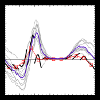 The climate community has begun to use and evaluate
the skill of general circulation models (GCMs) to
predict trends from seasonal to decadal time scales.
As part of the Canadian Sea Ice and Snow Evolution
(CanSISE) Network, I am evaluating the performance of
the Canadian Seasonal to Interannual Prediction
System (CanSIPS) on snow related variables using a
suite of historical forecasts.
The climate community has begun to use and evaluate
the skill of general circulation models (GCMs) to
predict trends from seasonal to decadal time scales.
As part of the Canadian Sea Ice and Snow Evolution
(CanSISE) Network, I am evaluating the performance of
the Canadian Seasonal to Interannual Prediction
System (CanSIPS) on snow related variables using a
suite of historical forecasts.
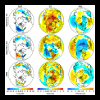 Because the climate system has a large amount of
natural variability, even on time scales of
years to decades, it's important to compare observed
trends to large ensembles of simulations in evaluating
whether or not the two are consistent with one another.
We have performed this analysis for 80 realizations
of the Community Climate System Model (CCSM4) from
the National Center for Atmospheric Research (NCAR).
Half of the realizations have a freely evolving ocean
that interacts with the atmosphere and other model
components and half of the realizations are forced
with historical values of sea surface temperatures
and sea ice. The results suggest that natural
variability due to climate noise as well as the
historical evolution of sea surface temperatures in
the Noth Pacific ocean have played roughly equal
roles on the trends in snow cover and snow water
equivalent over the last 30 years.
Because the climate system has a large amount of
natural variability, even on time scales of
years to decades, it's important to compare observed
trends to large ensembles of simulations in evaluating
whether or not the two are consistent with one another.
We have performed this analysis for 80 realizations
of the Community Climate System Model (CCSM4) from
the National Center for Atmospheric Research (NCAR).
Half of the realizations have a freely evolving ocean
that interacts with the atmosphere and other model
components and half of the realizations are forced
with historical values of sea surface temperatures
and sea ice. The results suggest that natural
variability due to climate noise as well as the
historical evolution of sea surface temperatures in
the Noth Pacific ocean have played roughly equal
roles on the trends in snow cover and snow water
equivalent over the last 30 years.
Previous Research
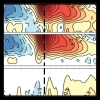 A previous topic of my current research was on better
understanding and diagnosing the coupling which
occurs in the atmosphere between the bottom
weather layer, the troposphere, and the stable
overlying layer, the stratosphere. It's currently
unresolved how much of an influence the overlying
stratosphere would be able to exert (if any) on
the troposphere, however there are observations
which suggest that the dynamics between the two
are coupled.
A previous topic of my current research was on better
understanding and diagnosing the coupling which
occurs in the atmosphere between the bottom
weather layer, the troposphere, and the stable
overlying layer, the stratosphere. It's currently
unresolved how much of an influence the overlying
stratosphere would be able to exert (if any) on
the troposphere, however there are observations
which suggest that the dynamics between the two
are coupled.
Listed below are a selection of previous projects on which I've worked. They range from parts of my Ph.D. thesis to more "fun-type" projects. More information can be found by clicking on the accompanying pictures.
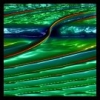 I have performed research on the interactions between the gas-disks and protoplanets that are thought
to exist in early solar systems. Such systems can be described by the Euler equations on a cylindrical grid.
I have developed my own code to solve these equations based on a TVD (Total Variation Diminishing)
algorithm. The code is able to capture high Reynolds number flow thus allowing less-smooth interactions
to be seen such as asymmetric clearing of gas around the planet.
I have performed research on the interactions between the gas-disks and protoplanets that are thought
to exist in early solar systems. Such systems can be described by the Euler equations on a cylindrical grid.
I have developed my own code to solve these equations based on a TVD (Total Variation Diminishing)
algorithm. The code is able to capture high Reynolds number flow thus allowing less-smooth interactions
to be seen such as asymmetric clearing of gas around the planet.
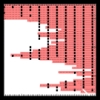 I have also studied planet ejection from binary systems. Planets that are members of binary star systems
experience gravitational tugs from both stars of the system (for reference, roughly half the stars in our sun's local
neighborhood are in binary systems). These gravitational tugs will eject the planet from the system unless the planet
hugs close enough to one of the stars or alternatively if it remains far enough away from both stars. This
project examined the physical mechanisms for the ejection of planets when the first condition does not hold.
I have also studied planet ejection from binary systems. Planets that are members of binary star systems
experience gravitational tugs from both stars of the system (for reference, roughly half the stars in our sun's local
neighborhood are in binary systems). These gravitational tugs will eject the planet from the system unless the planet
hugs close enough to one of the stars or alternatively if it remains far enough away from both stars. This
project examined the physical mechanisms for the ejection of planets when the first condition does not hold.
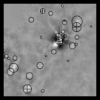 During my Master's Degree at the University of Toronto, I worked with
Doug Johnstone
examining star formation scenarios. We used submillimeter observations of density clumps found in the nearby
star forming regions of Rho Ophiuchus and Orion to postulate different scenarios for the collapse of the observed
clumps into stars.
During my Master's Degree at the University of Toronto, I worked with
Doug Johnstone
examining star formation scenarios. We used submillimeter observations of density clumps found in the nearby
star forming regions of Rho Ophiuchus and Orion to postulate different scenarios for the collapse of the observed
clumps into stars.
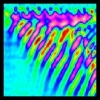 Work and results from a
mathematics laboratory(!) at the
University of Alberta where internal gravity waves were
generated using sinusoidal topography in a water tank. The generation of such waves models the actual flow of
air over mountain ranges. These waves propagate upwards through our atmosphere until they break at higher
altitudes depositing their momentum and thereby affecting the background flow at those levels.
Work and results from a
mathematics laboratory(!) at the
University of Alberta where internal gravity waves were
generated using sinusoidal topography in a water tank. The generation of such waves models the actual flow of
air over mountain ranges. These waves propagate upwards through our atmosphere until they break at higher
altitudes depositing their momentum and thereby affecting the background flow at those levels.
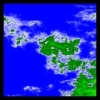 It's possible to model planet surfaces as fractal objects using Brownian motion. Linked here is a brief interactive
introduction to Brownian Motion/Noise and Fractals as well a method used to render fractal surfaces of "Earths". This
demo was put together by myself and a fellow student for the 1998 Canadian Undergraduate Physics Conference.
It's possible to model planet surfaces as fractal objects using Brownian motion. Linked here is a brief interactive
introduction to Brownian Motion/Noise and Fractals as well a method used to render fractal surfaces of "Earths". This
demo was put together by myself and a fellow student for the 1998 Canadian Undergraduate Physics Conference.
